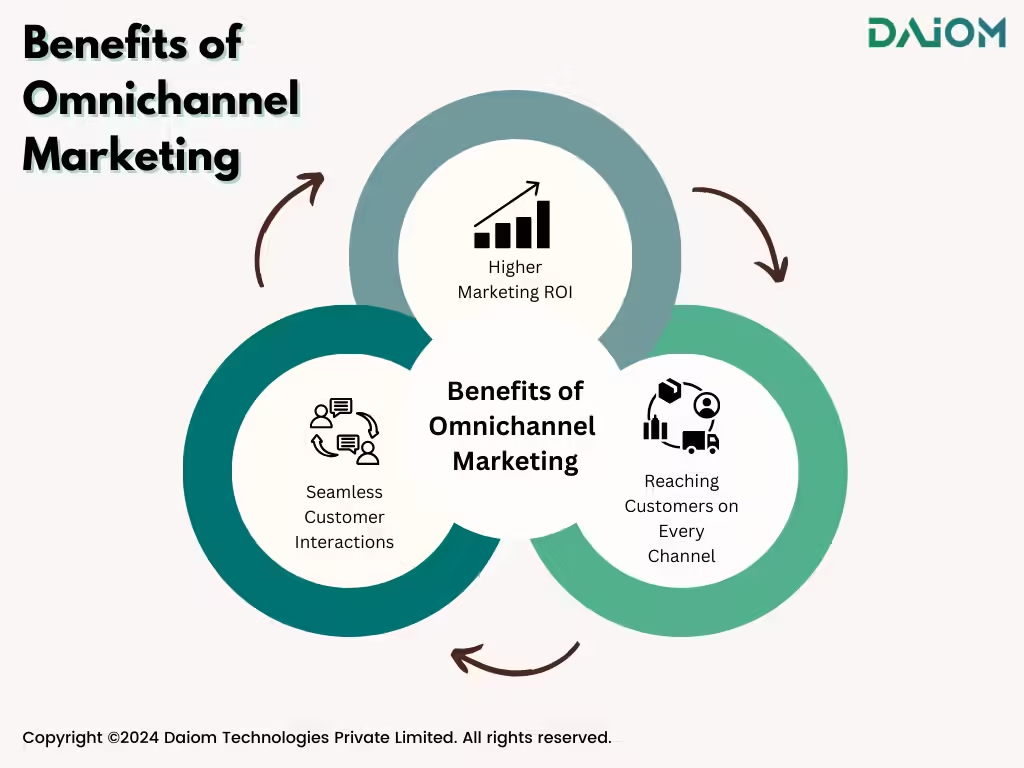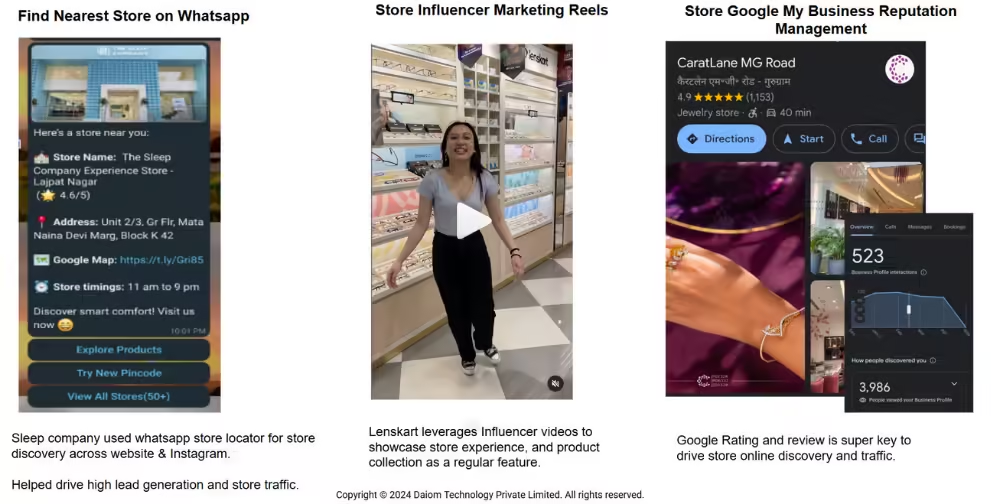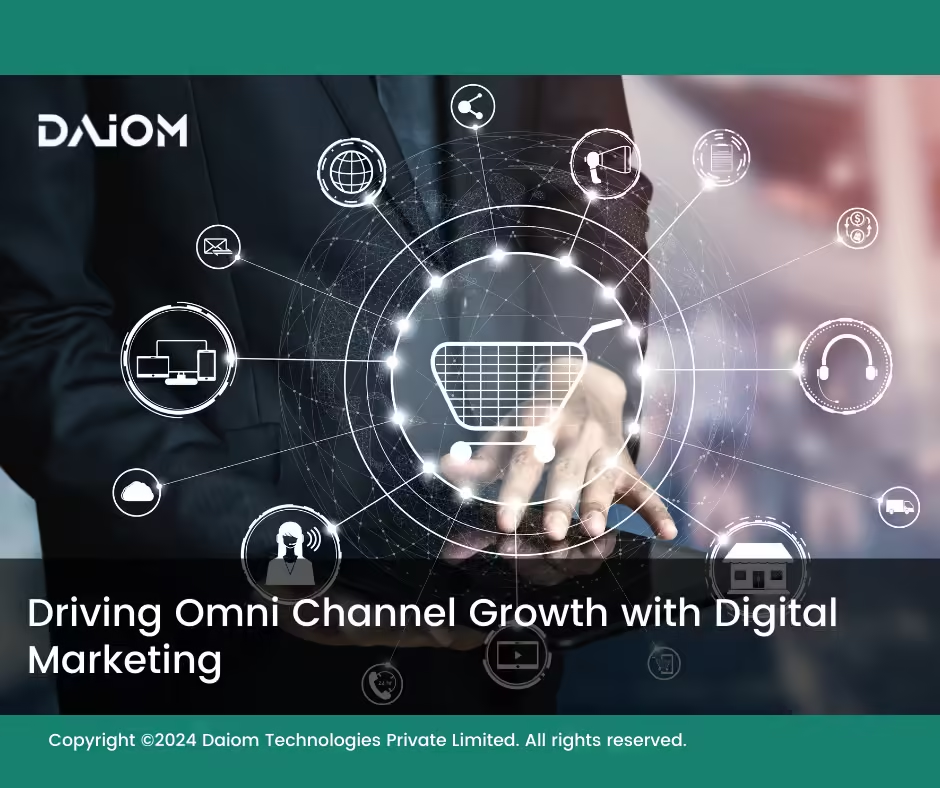Customers now spend time across an array of platforms—conversational channels like SMS and WhatsApp, social media platforms like Instagram and Facebook, and even traditional media like TV. To stay relevant, brands must position themselves in the channels most frequently used by their target audience.
There are only 7% of the customer who just prefer shopping online and only 20% of them are only store only shoppers. While 73% of the customer use multiple channels throughout the customer journey.
For example, a TV ad might resonate with older audiences, while Instagram reels might capture younger ones. The key is to engage customers where they already are, ensuring your message reaches them effectively.
Consistency is critical in omnichannel marketing. Customers should experience a smooth, uninterrupted journey, regardless of how they interact with the brand.
Disjointed messaging or mismatched transitions between platforms can frustrate customers. For example, if a WhatsApp ad promotes a chair, the linked webpage should show the same product, not something unrelated.
By maintaining a continuous flow of information and context across channels, brands create intuitive and satisfying customer journeys that build trust and loyalty.
We’ve created a simple guide with tips and strategies to help you build an effective omnichannel marketing strategy. Let’s get started!
Table of Contents
1. What is an Omnichannel Marketing Strategy?
A strong omnichannel strategy works seamlessly with the marketing funnel.
At the top of the funnel, the focus is on building awareness using broad-reach tactics like TV ads, social media campaigns, and Local SEO. These methods help brands capture the attention of potential customers and bring them into their ecosystem.
As customers move to the middle of the funnel, the goal shifts to engagement and retargeting. Platforms like Facebook and personalized email campaigns play a key role here, keeping the brand top of mind and encouraging further interaction.
Finally, the loyalty stage is about maintaining consistency and delivering meaningful messages across channels. For instance, if a customer sees a TV ad, downloads the app, and later engages with a retargeted social media ad, the entire experience should feel connected. This seamless journey ensures the brand leaves a lasting impression, building trust and loyalty over time.
2. What Are The Benefits of Omnichannel Marketing?
Implementing an omnichannel marketing strategy can transform how your business interacts with customers. Let’s explore the key benefits of adopting an omnichannel approach.

- Higher Marketing ROI: With an omnichannel approach, businesses optimize campaigns by unifying strategies and data. This reduces wasted efforts and maximizes returns, making every penny count.
- Seamless Customer Interactions: An omnichannel strategy ensures customers experience consistency, whether they engage through a website, a physical store, or social media. This cohesive approach strengthens trust and enhances satisfaction.
- Reaching Customers on Every Channel: Consumers are active across multiple platforms—online and offline. Omnichannel marketing allows businesses to connect with them wherever they are, ensuring no potential engagement is missed.
3. Different Omnichannel Marketing Channels to Drive Success
Brands today use a mix of strategies to connect with audiences, build trust, and boost engagement. Omnichannel marketing brings all these efforts together, ensuring customers experience smooth interactions across different channels. Here’s how brands leverage various techniques to achieve this:

3.1 Diverse Channels for Discovery and Engagement
Brands reach customers through multiple touchpoints—both online and offline. Social media platforms like Instagram and Facebook create awareness, while SEO ensures brands are easily discoverable through search engines.
Messaging platforms like WhatsApp, SMS, and email allow for direct, personalized communication. By analyzing customer data, brands tailor messages to match the customer’s interests and stage in the buying journey.
3.2 Different Types of Marketing
Brands don’t just rely on one approach to connect with their audiences. They leverage several types of marketing to build awareness, nurture loyalty, and maintain engagement. Here’s how:
- Brand Marketing: This is about storytelling and emotional connections. For instance, Coca-Cola focuses on happiness and togetherness in its ads, aligning its values with its audience.
- Performance Marketing: Data-driven and results-oriented, this approach measures the impact of efforts like paid ads, ensuring every dollar drives measurable outcomes. Think Facebook ads that track clicks and conversions.
- Retention Marketing: After the first purchase, strategies like Amazon Prime’s fast shipping, exclusive deals, and personalized recommendations keep customers coming back. Read more – The Ultimate Guide To Customer Retention Marketing Tools.
- Social Media Marketing: Platforms like Instagram and TikTok help brands engage authentically. Nike, for example, connects with athletes by sharing motivational content and behind-the-scenes stories, building community and trust. Read more – Driving Business Impact through Social Media Marketing.
3.3 Seamless Customer Journeys Through Omnichannel
The beauty of omnichannel marketing is how it integrates these strategies into a cohesive journey. A customer might first see a brand’s story on TV (Brand Marketing), click an Instagram ad (Performance Marketing), make a purchase, and later receive a loyalty discount for their next buy (Retention Marketing).
Each interaction feels connected and intentional, making the customer’s experience smooth and engaging.
4. Driving Engagement Via Online-to-Offline & Vice Versa
Bridging online and offline experiences is essential for driving footfall to physical stores. Strategies like Local SEO can make it easier for customers to locate nearby outlets, while store locators and clear “Visit Store” CTAs in online campaigns encourage in-person visits.
Read more – Bridging Online and Offline: The Omnichannel Approach
Personalized incentives, such as exclusive in-store discounts, can further motivate customers to transition from browsing online to shopping offline, creating a comprehensive brand experience.
4.1 How Can Online Enable Offline?
The relationship between online and offline channels is key for creating a smooth customer journey. Here’s how digital strategies can effectively drive offline engagement and support physical stores.

- Digital Media KPIs: KPIs like brand awareness and customer acquisition lay the foundation for offline success. When online awareness is strong, it naturally drives more potential customers to offline stores, increasing foot traffic and sales.
- Building a Digital Identity for Offline Stores: Offline stores need a solid online presence. This includes having an optimized Google profile, gathering reviews and ratings, and showcasing photos of the store. A strong digital identity ensures potential customers can easily find the store and feel confident in visiting.
- Social Media & Influencer Marketing: Social media plays a key role in driving traffic to offline stores. By sharing engaging posts and collaborating with influencers, brands can generate excitement and encourage followers to visit their physical locations. This creates a direct link between online engagement and offline visits.
- Nudging Customers to Offline Channels: Digital platforms can gently push customers toward offline stores. Notifications about exclusive in-store promotions or limited-time offers can prompt online users to make the jump to an in-store experience. These subtle reminders can effectively convert online interest into offline visits.
- Easy Returns & Exchanges: Offering hassle-free returns or exchanges in offline stores for online purchases is a great way to build trust with customers. This convenience not only enhances the customer experience but also encourages them to visit the physical store, strengthening the connection between online and offline channels.
4.2 How Offline Can Enable Online?
Offline efforts, such as strategically placed QR codes and interactive in-store experiences, can significantly enhance a brand’s online performance. For example, Decathlon seamlessly connects its offline stores with its online platform through QR code scanning.
Read more – Decathlon’s Omni Channel with Endless Aisle powered by QR

Here’s how Decathlon bridges the gap:
- Converting In-Store Shoppers to Online Visitors: Decathlon makes the in-store experience seamless with strategically placed QR codes. Shoppers can scan these codes to access detailed product information, check online inventory, or order items not available on-site. This not only enhances customer convenience but also channels traffic directly to Decathlon’s website or app, keeping the brand connected with customers even after they leave the store.
- Attracting and Engaging New Shoppers: By offering QR codes that link to exclusive deals, promotions, or personalized product suggestions, Decathlon creates new opportunities to engage first-time visitors. Shoppers who might have casually browsed the store can be guided to explore more options online, converting them into loyal digital customers and expanding Decathlon’s online reach.
- Building Credibility and Trust: Decathlon’s physical stores act as a trusted touchpoint, where customers can see and try products firsthand. When they scan QR codes to transition online, the positive in-store interaction reassures them about the brand’s reliability. This offline-to-online journey strengthens customer confidence and encourages future online purchases.
5. Conclusion
As digital channels keep changing, marketers need to keep up with new trends and adapt quickly. This helps them add new channels to their omnichannel strategies smoothly.
By doing so, businesses can reach customers through the channels they prefer, leading to better customer retention. Plus, it allows customers to switch between different channels effortlessly, creating a smoother and more satisfying experience.
If you’d like to discuss how we can help enhance and optimize your Omnichannel, Retention and growth marketing strategies, we’d be happy to set up a consultation call. Feel free to reach out to us at alibha@daiom.in
For more informative content and blog, follow and stay tuned to DAiOM.
Subscribe to our NEWSLETTER!


